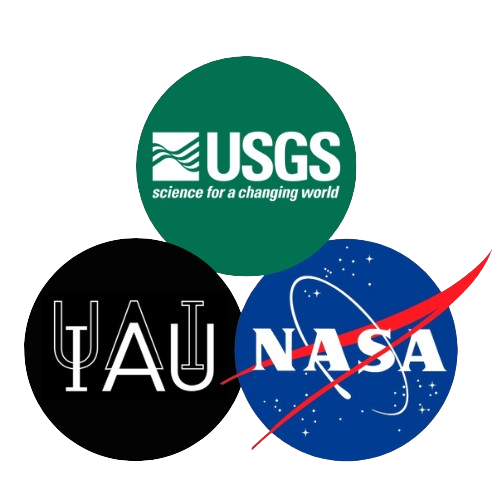Planetary features are named only when members of the professional science community have a specific scientific need to name a planetary surface feature. Scientists (or students, with a letter of support from the advisor) preparing manuscripts for peer-reviewed journal articles or maps may request a planetary feature be named by following the Name Request Instructions or by emailing Tenielle Gaither at tgaither@usgs.gov. Requestors submit a short scientific justification describing why the feature needs to be named, and a timeline for publication of the work in which the name will appear. Also required are annotated and unannotated images of the feature, along with data about the feature (feature type, latitude/longitude in the correct coordinate system, and size). Specific name suggestions for feature names will be considered, but final selection of the names is the responsibility of the IAU. Name suggestions must fit the designated theme for each feature type (descriptor terms). An authoritative reference for the name is required; Wikipedia, Google Maps, etc. are not acceptable references. Proposers should review the IAU Rules and Conventions for additional guidance in proposing a name that fits the guidelines.
Name proposals are first reviewed by the appropriate Task Group, and then by the Working Group for Planetary System Nomenclature (WGPSN), which gives official approval of names. The name approval process for straightforward requests for single feature names takes about one month; requests for multiple feature names will take longer. Upon successful review by vote of the members of the WGPSN, names are considered approved as official IAU nomenclature, and can be used on maps and in publications. Approved names are entered into the Gazetteer of Planetary Nomenclature, in which each approved feature name has its own page with descriptive information. Approved names are also listed in the Transactions of the IAU .
When the first images of the surface of a planet or satellite are obtained, new themes for naming features are chosen and names of a few important features are proposed, usually by the appropriate IAU Task Group in collaboration with the mission team. Later, as higher-resolution images and maps become available, names for additional features may be requested by investigators mapping or describing specific surfaces or topographic formations. Mission teams are encouraged to identify a single person to be a nomenclature point of contact for the team and to establish communication with the IAU 6-9 months before spacecraft landing.
Any objections to approved names based on significant substantive problems or inconsistent application of normal IAU naming conventions must be forwarded in writing or email to the IAU General-Secretary within three months from the time the name was published in the Gazetteer. The General-Secretary will make a recommendation to the WGPSN Chair as to whether or not the approved name(s) should be reconsidered. The General-Secretary, in concurrence with the IAU President, may seek the advice of external consultants.
The IAU page Naming of Astronomical Objects discusses the processes for naming dwarf planets and satellites of planets in the Solar System.
Inquiries should be sent to Tenielle Gaither, 2255 N. Gemini Drive, Flagstaff, Arizona 86001, or by email: tgaither@usgs.gov.


